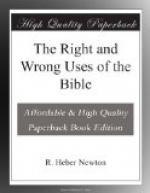The recognition of this common-sense principle, theoretically, would remand the darker doctrines of Christianity to such authority as the lower order of Biblical writings possess. The terrifying and torturing teachings of the New Testament are from obscure authors, or from the masters in their lower moods. The representations of a wrathful God, of an avenging Christ, of a hell of horrors, are found in such epistles as Second Thessalonians, whose authorship is uncertain; as Jude or Second Peter, about whose authorship and date we have only the probability that no apostle wrote them, and that they were written after the first, fresh inspiration had passed from the church. Rabbinical speculations and Greek superstitions show themselves at work in the Christian Church.[32] The unquestioned letters of Paul are sunny and sweet. In them we see the father of Christian Restorationism. If he knows anything of a dark side to the resurrection, as he shows elsewhere that he does, he leaves it in its own shadows; and in the height of this great argument of Corinthians brings to the front only the resurrection to life and joy. “Knowing the fear of the Lord we—persuade men.”
The first epistle of John is true to its favorite symbol of the light. There are no clouds in it. The God revealed in the greatest writings of the greatest authors of the New Testament is Love. The Christ they picture is Christus Consolator. The full breath of inspiration opens only the upper register of notes. The voices of the soul are buoyant, joyous, hopeful.
If you are willing to follow the most inspired writers, in their most inspired moods, up into the heights whither the divine afflatus bore them, you will mount above the cloud-level, and leave to those who lag after feebler guides on the lower ranges of truth, the chill mists that eat into the soul, while you rejoice in the light.
VI.
It is a wrong use of the Bible to manufacture cut of it any one uniform, system, of theology, as the fixed and final form of thought in which religion is to live.
Let me define these contrasting terms, so commonly confounded. Religion is man’s perception of the Power in whom we live and move and have our being, and his emotion towards this power. Theology is man’s conception of this Power, and his thought defined and formulated.
Religion is man’s feeling after God; theology is man’s grasp of God. The two are necessarily connected. They are different forms of one and the same force; the heat and the light which stream from God; but the heat and the light are not always equal. A worthy thought of God ought to sustain any worthy feeling towards Him. It generally does so. A heightened thought of God may often be found back of a rising flow of feeling after Him. More often the emotion precedes the conception; the vague, awed sense of God travails till a new thought




